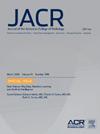Investigating the Role of Area Deprivation Index in Observed Differences in CT-Based Body Composition by Race
IF 5.1
3区 医学
Q1 RADIOLOGY, NUCLEAR MEDICINE & MEDICAL IMAGING
引用次数: 0
Abstract
Objectives
Differences in CT-based body composition (BC) have been observed by race. We sought to investigate whether indices reporting census block group-level disadvantage, Area Deprivation Index (ADI) and Social Vulnerability Index (SVI), age, gender, and clinical factors could explain race-based differences in BC.
Methods
The first abdominal CT examinations for patients in Durham County at a single institution in 2020 were analyzed using a fully automated and open-source deep learning BC analysis workflow to generate cross-sectional areas for skeletal muscle (SMA), subcutaneous fat (SFA), and visceral fat (VFA). Patient-level demographic and clinical data were gathered from the electronic health record. State ADI ranking and SVI values were linked to each patient. Univariable and multivariable models were created to assess the association of demographics, ADI, SVI, and other relevant clinical factors with SMA, SFA, and VFA.
Results
In all, 5,311 patients (mean age, 57.4 years; 55.5% female; 46.5% Black; 39.5% White; 10.3% Hispanic) were included. At univariable analysis, race, ADI, SVI, gender, body mass index, weight, and height were significantly associated with all body compartments (SMA, SFA, and VFA, all P < .05). At multivariable analyses adjusted for patient characteristics and clinical comorbidities, race remained a significant predictor, whereas ADI did not. SVI was significant in a multivariable model with SMA.
Discussion
The results of this retrospective study suggest that neighborhood indices are insufficient proxies for the socio-economic and environmental factors likely driving race-based differences in CT-based BC. Future research should analyze individual census tract variables and patient level data to better understand this relationship.
研究区域剥夺指数在观察到的基于ct的身体组成的种族差异中的作用。
目的:观察不同种族基于ct的身体组成(BC)的差异。我们试图调查报告人口普查区块群体水平劣势、区域剥夺指数(ADI)和社会脆弱性指数(SVI)、年龄、性别和/或临床因素的指数是否可以解释基于种族的身体成分差异。方法:使用全自动和开源深度学习BC分析工作流程对2020年Durham县单一机构患者的首次腹部CT检查进行分析,以生成骨骼肌(SMA),皮下脂肪(SFA)和内脏脂肪(VFA)的横截面面积。从电子健康记录中收集患者层面的人口统计和临床数据。州ADI排名和SVI值与每个患者相关联。建立单变量和多变量模型来评估人口统计学、ADI、SVI和其他相关临床因素与SMA、SFA和VFA的关系。结果:5311例患者(平均年龄57.4岁;女性55.5%,黑人46.5%;39.5%白人10.3%西班牙裔)。在单变量分析中,种族、ADI、SVI、性别、BMI、体重和身高与所有体区(SMA、SFA和VFA)均显著相关
本文章由计算机程序翻译,如有差异,请以英文原文为准。
求助全文
约1分钟内获得全文
求助全文
来源期刊

Journal of the American College of Radiology
RADIOLOGY, NUCLEAR MEDICINE & MEDICAL IMAGING-
CiteScore
6.30
自引率
8.90%
发文量
312
审稿时长
34 days
期刊介绍:
The official journal of the American College of Radiology, JACR informs its readers of timely, pertinent, and important topics affecting the practice of diagnostic radiologists, interventional radiologists, medical physicists, and radiation oncologists. In so doing, JACR improves their practices and helps optimize their role in the health care system. By providing a forum for informative, well-written articles on health policy, clinical practice, practice management, data science, and education, JACR engages readers in a dialogue that ultimately benefits patient care.
 求助内容:
求助内容: 应助结果提醒方式:
应助结果提醒方式:


